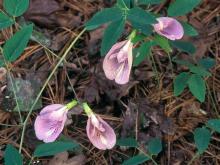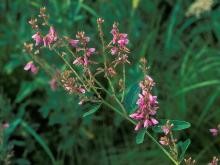Wildflowers, Grasses and Other Nonwoody Plants
Media

Species Types
Scientific Name
Camassia scilloides
Description
In spring, wild hyacinth bears an elongated cluster of pale blue flowers with prominent anthers that sway on stalks up to 2 feet tall.
Media

Species Types
Scientific Name
Cirsium altissimum
Description
Tall thistle is a native thistle that can grow to be 10 feet tall! To identify it, notice its leaves, which are unlobed (though they may be wavy or have only shallow, broad lobes), are felty-hairy beneath, and have prickles only along the edges.
Media

Species Types
Scientific Name
Delphinium tricorne
Description
Dwarf larkspur is a single-stemmed perennial with an upright flower stalk bearing racemes of bluish-purple flowers. Like other larkspurs, there is a spurlike appendage behind each flower.
Media

Species Types
Scientific Name
Lactuca floridana
Description
A true lettuce that can be eaten as a cooked or salad green, Florida lettuce has lavender to purplish blue flowers and grows statewide.
Media

Species Types
Scientific Name
Triodanis perfoliata (formerly Specularia perfoliata)
Description
Clasping Venus' looking glass is a single-stemmed plant with purple or blue star-shaped flowers and bluntly toothed, alternate leaves that clasp the stem. It's scattered statewide in a variety of habitats and blooms May-June.
Media

Species Types
Scientific Name
Amsonia illustris
Description
Often found on gravelly Ozark streamsides, shining blue star lifts its clusters of showy, light-blue flowers in late spring. A top choice for native wildflower gardening, it is interesting spring, summer, and fall.
Media

Species Types
Scientific Name
Sorghum halepense
Description
Johnson grass is a native of the Mediterranean that is invasive in our country. It’s a weed that infests cropland and degrades native ecosystems, and heavy infestations are found in all the major river bottoms of Missouri.
Media

Species Types
Scientific Name
Blephilia ciliata
Description
Square, unbranching stems, opposite leaves, two-lipped flowers, and a mild minty fragrance are clues Ohio horsemint is in the mint family. Tight, rounded flower clusters are stacked atop one another at the stem tips.
Media

Species Types
Scientific Name
Clitoria mariana
Description
Butterfly pea is a low, shrubby, or twining perennial in the pea family, with showy, butterfly-like flowers. The leaves are compound with three leaflets. This species grows in the southern parts of Missouri, in acid soils.
Media

Species Types
Scientific Name
Desmodium spp. (17 species in Missouri)
Description
Missouri has 17 species of tick trefoils, which live in a variety of habitats. Hikers know them well from their chains of hairy little seedpods that stick to clothing like parasites!
See Also
About Wildflowers, Grasses and Other Nonwoody Plants in Missouri
A very simple way of thinking about the green world is to divide the vascular plants into two groups: woody and nonwoody (or herbaceous). But this is an artificial division; many plant families include some species that are woody and some that are not. The diversity of nonwoody vascular plants is staggering! Think of all the ferns, grasses, sedges, lilies, peas, sunflowers, nightshades, milkweeds, mustards, mints, and mallows — weeds and wildflowers — and many more!





















